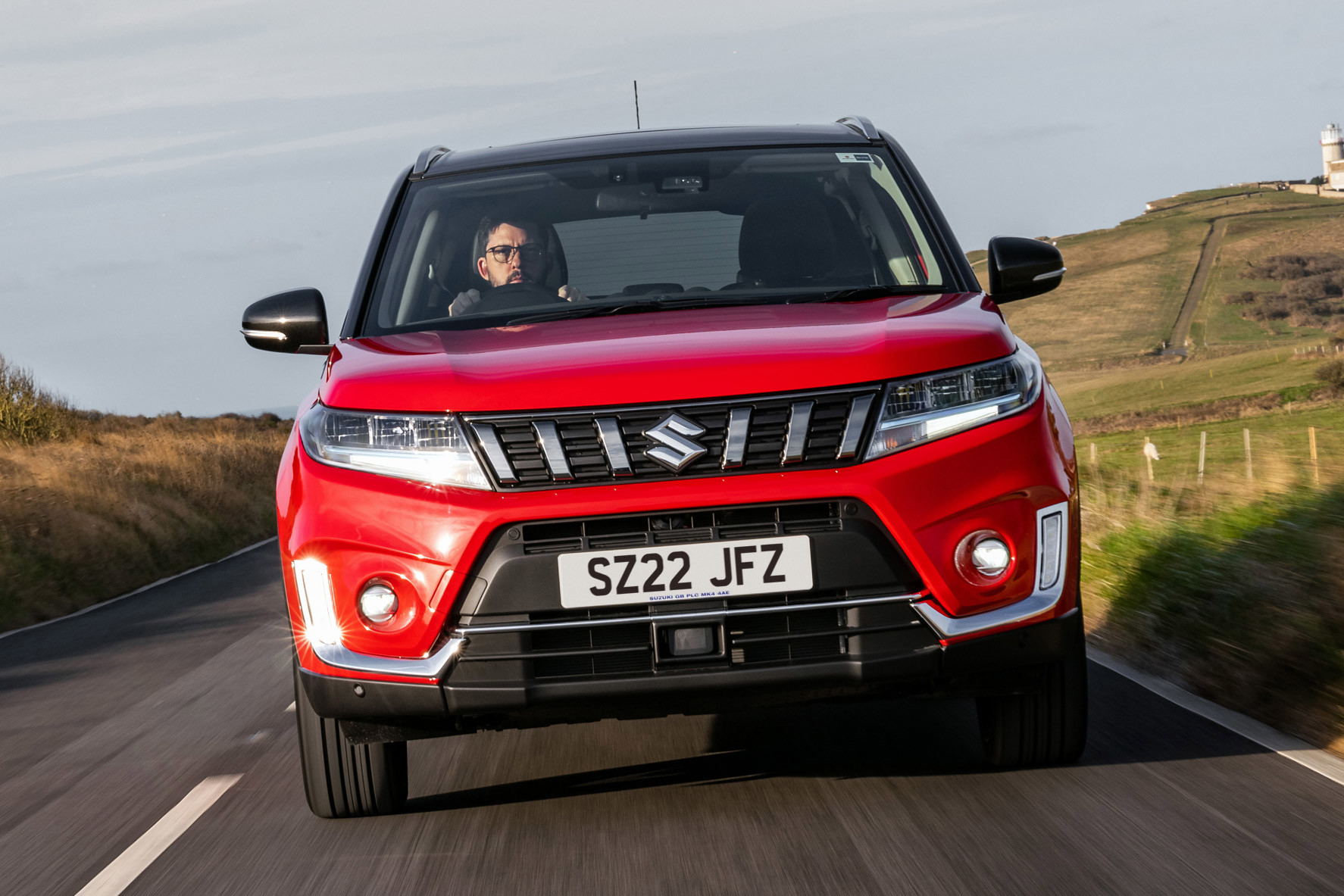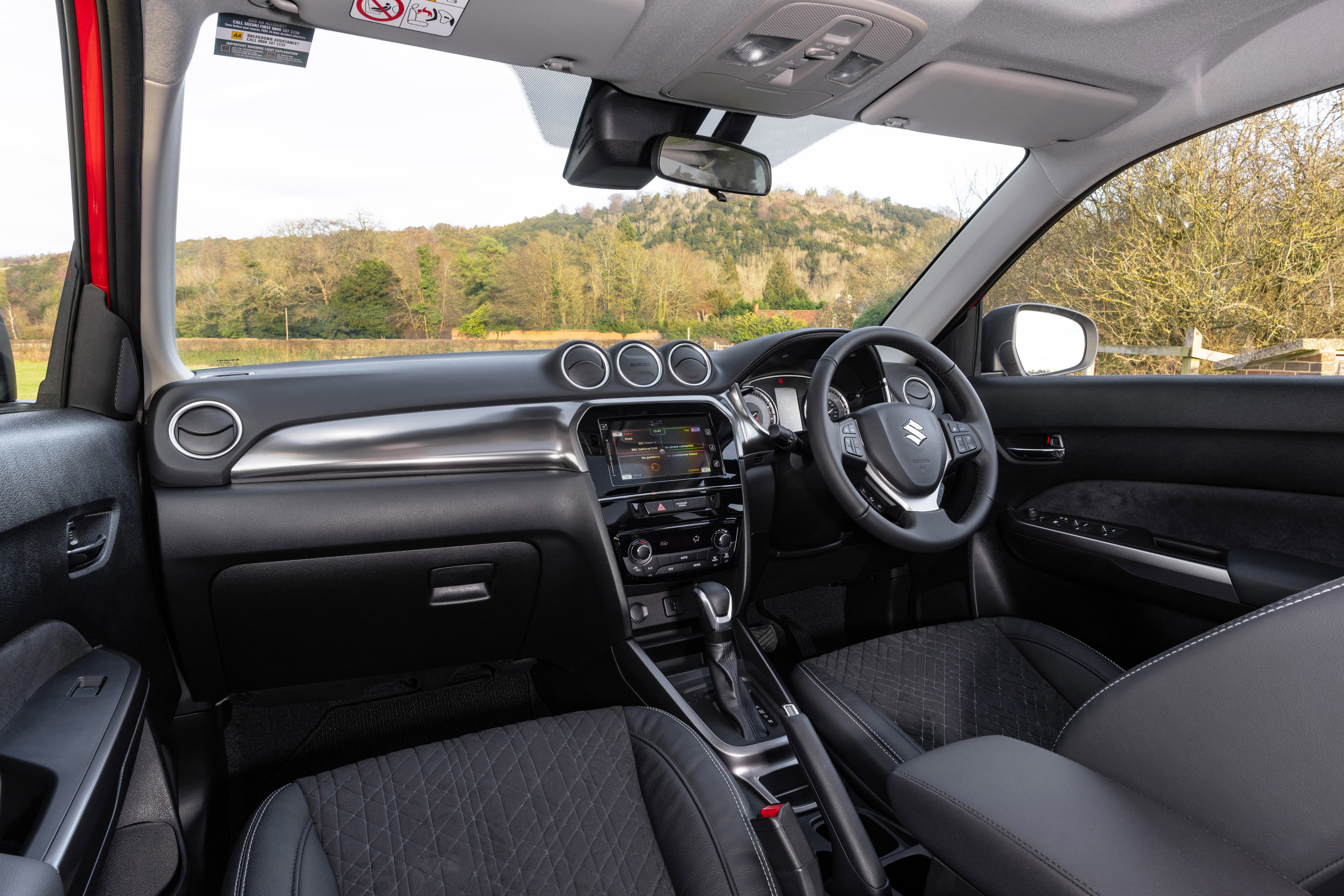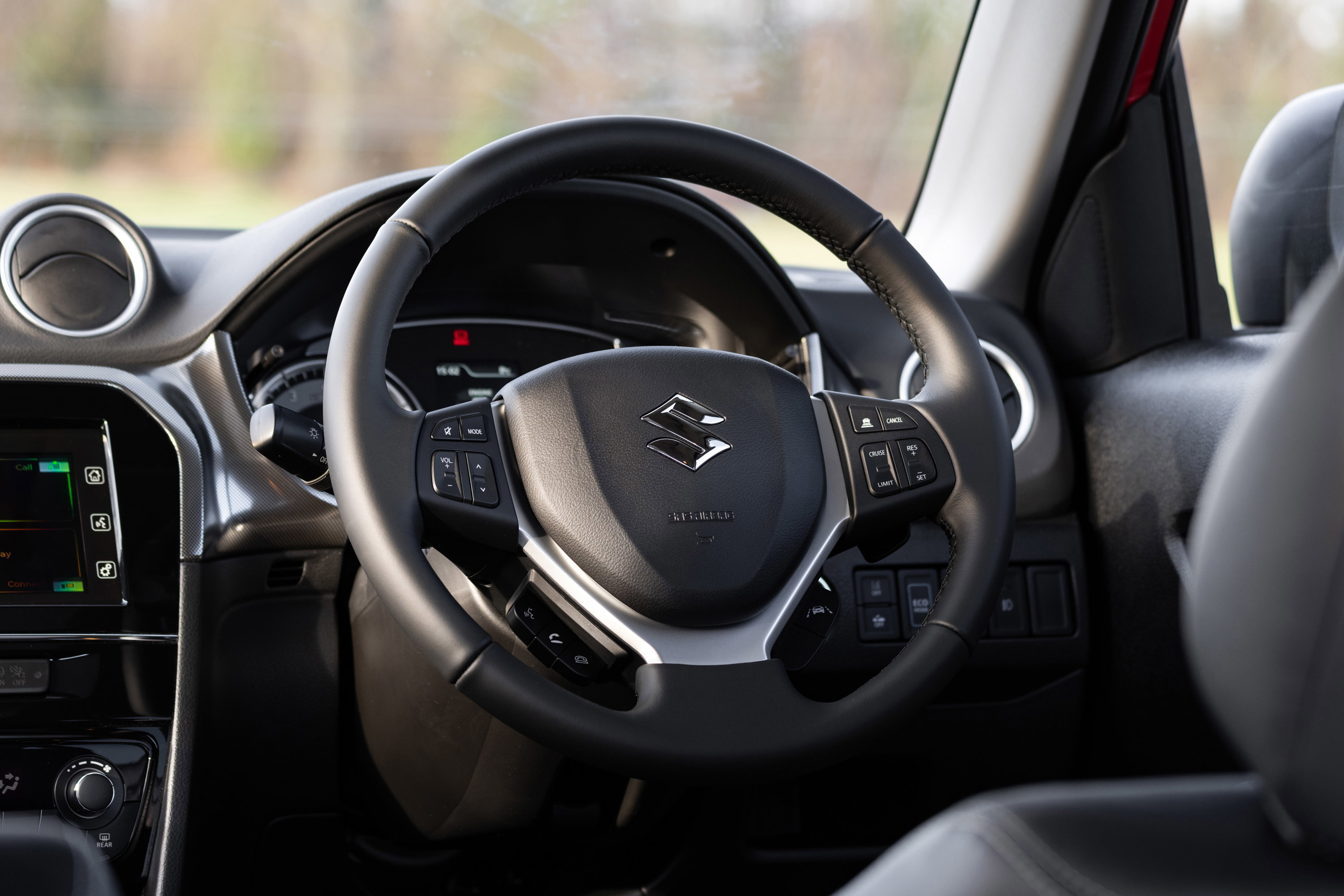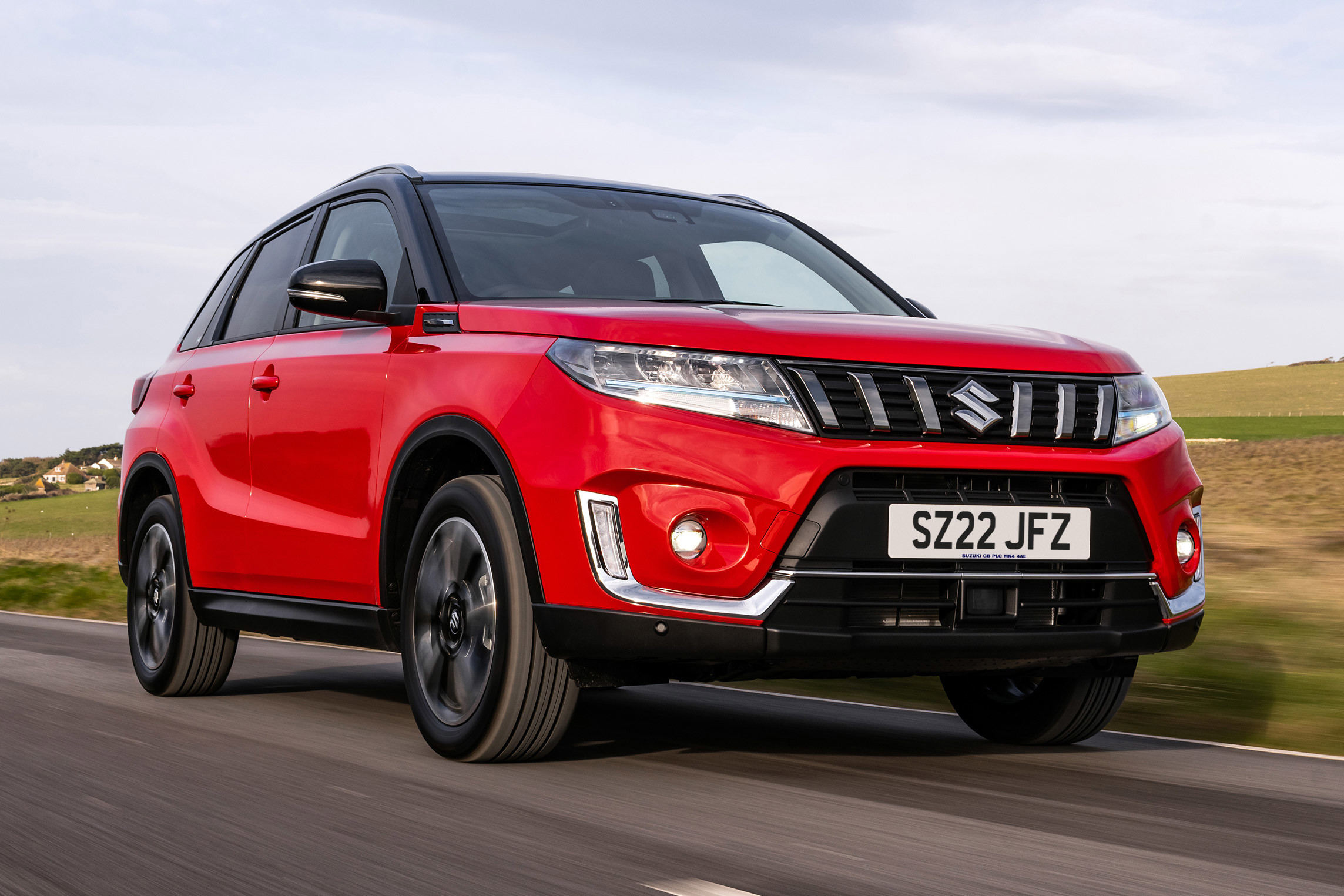Quick overview
- Spacious interior
- Solid build quality
- Hybrid power
- Four-wheel drive option
- Feels dated
- Full hybrid’s automated manual ’box
- Slow performance
- Boot capacity
The Suzuki Vitara has been around in one form or another for more than three decades and its unabashed in being a more practical SUV than some of its rivals that put style at the head of their priority list. It might not make the Vitara a full-on farmer’s mud-plugging off-roader, but the Vitara will get you into and out of tight spots far better than most others in this class.
There is the option of Allgrip four-wheel drive with the both the mild- and full hybrid versions of the Vitara. The full hybrid model comes with an automated manual gearbox, which is not the most enjoyable to use, but decent economy and emissions make it hard to ignore this version over the standard six-speed manual transmission in the mild hybrid model. With the mild hybrid, you get a 1.4-litre Boosterjet turbo petrol engine that gets the job done. For the full hybrid car, a 1.5-litre petrol motor has less power than the 1.4, but there’s more assistance from its electric motor. Even so, the 1.5-litre model is slow to the point where it can become a nuisance in everyday driving.
What you won’t mind when using the Vitara as your daily car is the amount of cabin space it offers. You sit up high to get a good view of the road, while passengers have plenty of room for heads, legs, knees and shoulders. There’s also a reasonable boot for luggage or Labradors. On top of this, the Vitara is solidly built, even if it’s not the most stylish interior to spend time in.
With a hefty amount of standard luxury equipment in both trim levels, and decent safety kit included too, the Suzuki Vitara is a no-nonsense small SUV for those who need to core traits of this type of car over other considerations such as style or fashion.
Prices
The Suzuki Vitara range begins with the SZ-T trim with the 1.4-litre Boosterjet mild hybrid engine. In front-wheel drive form with the manual gearbox, it costs from £23,749, while swapping to the automatic gearbox adds £1350 to the price. If you’d rather have four-wheel drive and the manual gearbox with this engine, the price goes from £25,550. A 1.5-litre Full Hybrid SZ-T with automatic gearbox begins at £25,499. Next up is the SZ5 trim, with a 1.4-litre, front-drive car with manual gearbox costing from £25,749, while the 1.5 Full Hybrid with auto is £27,499. Adding four-wheel drive to these cars costs a further £1800. If you’re happy to take a Vitara from Suzuki’s stock, you could save up to £2000 on a brand-new model. Choose a nearly new model instead and you could save as much as £4000 on a car with less than 5000 miles under its wheels. A three-year old Vitara that has covered average miles for its age will cost from around £12,000.
Infotainment, comfort and practicality
The Suzuki Vitara straddles the gap between more fashion-led small SUVs and those, like Suzuki’s own Jimny, that are much more serious workhorses. This is obvious from the moment you settle into the Vitara’s driver’s seat as it places you upright and quite high in the car to give excellent all-round vision. The squared-off styling of the Vitara helps here too, but only the higher spec SZ5 trim comes with front and rear parking sensors as standard. This isn’t such a concern in the Suzuki as in some other small SUVs as the driver can see all four corners of the car well. You can adjust the seat for height and the steering wheel moves for depth and angle, too, so it’s easy to hone the seating position to suit you. It also provides ample space, and there are plenty of spots around the driver to stash small items.
The main dash display of the Vitara is clear to read and functional with its analogue dials for speed and revs. There’s a small digital display between these instruments that you can scroll through using the steering wheel buttons. In the centre of the dash sit the simple rotary and push button controls for the air conditioning, which are as easy as any to use while driving.
Above this sits the 7.0-inch infotainment touchscreen, which is positioned lower in the dash than in many rivals like the Ford Puma or Peugeot 2008. This helps the Suzuki’s screen look more integrated into the dash, but it also means you need to glance further from the road to read it while on the move. It doesn’t help the Suzuki’s case that its infotainment is far from the most intuitive to use due to the graphics it uses and the response to inputs is not always as quick or sharp as you’d like. It does come with Apple CarPlay and Android Auto as standard to hook up to your phone’s apps, but the Suzuki’s touchscreen now looks and feels quite dated.
Head into the back seats of the Vitara and there’s nothing wrong with the amount of space it offers passengers. This may be a small SUV, but its upright styling means occupants sit with hips and knees at right angles. This is good for space and for comfort, to the Vitara can happily carry two adults back here, or three when required. Kids will be happy and there are Isofix child seat mounts in the two outer chairs to safely tether kiddy seats.
The rear seats split 60-40 and tumble forwards to free up more boot space, but that’s as clever as it gets for the Suzuki’s load options. With the seats up, there are 362-litres of capacity in the mild hybrid model, which drops to 289-litres in the full hybrid model. Fold the back seats down and the mild hybrid offers up 1160-litres and the full hybrid slightly less. Both have boot floors that sit flush with the load sill, and the tailgate opens to reveal a broad, tall aperture that makes it a doddle to fit in bigger items.
Which 2015 Suzuki Vitara model should you buy?
Suzuki keeps it simple when it comes to trims for the Vitara, with a choice of SZ-T or SZ5 to pick from. The SZ-T comes with seven airbags, hill hold control, lane departure warning and prevention, hill descent control for Allgrip models, and traffic sign recognition. You also get adaptive cruise control, 17-inch alloy wheels, silver roof rails, automatic air conditioning, 7.0-inch infotainment touchscreen with Apple CarPlay and Android Auto, and automatic headlights and wipers. Move up to the SZ5 and you enjoy a panoramic sliding sunroof, front and rear parking sensors, and keyless entry and ignition. You also get suede seat upholstery, electric folding door mirrors, and sat-nav.
Value for money: how much does a 2015 Suzuki Vitara cost to buy and run?
Looking at fuel economy and emissions, the 1.4 Boosterjet Mild Hybrid model offers 52.7mpg and 121g/km CO2 output with the manual gearbox and front-wheel drive. If you’d rather have the Allgrip model, those figures change to 48.3mpg and 132g/km, respectively. With the 1.5 Full Hybrid model that comes with the AGS automated manual transmission, it returns 53.0mpg and 121g/km in front-drive form. Add four-wheel drive to this version and it provides 48.4mpg and 132g/km of carbon dioxide emissions. This means the front-wheel drive versions sit in the 27% band for company car Benefit in Kind rates in 2022-2023, while the all-wheel drive models are in the 29% bracket. The Vitara sits in groups 21 to 22 for insurance, depending on which trim you choose, which makes it more expensive to get cover for than most of its rivals.
Verdict: Should I buy a 2015 Suzuki Vitara?
Suzuki has an appealingly simple approach to the Vitara, which is partly founded on the car’s ability to deal with more adverse conditions than most of its contenders. It helps the Vitara is also available with four-wheel drive that delivers a dose of all-weather driving ability and makes this SUV a car for those who need a workhorse as well as a compact crossover.
Both of the trim levels on offer with the Vitara come with a good array of kit, though it’s a shame the SZ-T doesn’t get parking aids included. However, there is plenty of safety kit as standard on all models. What we’re not so keen on is the 1.5 Full Hybrid engine, especially with four-wheel drive that blunts performance more than we’re willing to accept. Stick with the 1.4 Boosterjet engine and front-drive and you have the ideal Vitara for most occasions.








